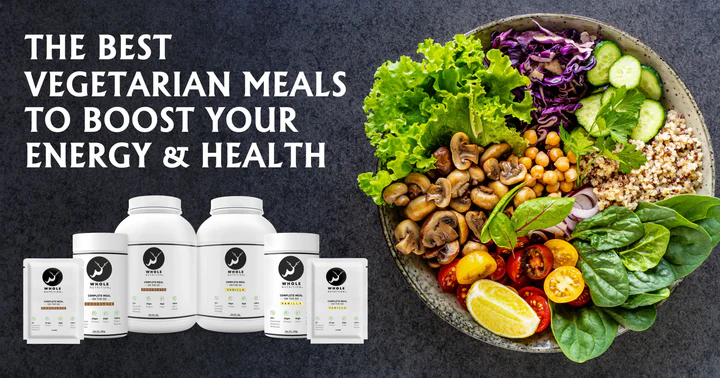Eating a plant-based diet doesn’t mean you have to miss out on protein. With the right combination of ingredients, you can enjoy delicious, nutritious meals that fuel your body and help you meet your protein needs. Whether you’re a vegetarian, vegan, or simply looking to incorporate more plant-based meals into your diet, creating a high protein vegetarian meal is easier than you might think. This guide will walk you through the best ingredients, tips, and meal ideas to ensure you’re getting plenty of protein from your vegetarian meals.
At Whole Nutrition, we specialize in providing clean, plant-based nutrition to support a healthy lifestyle. For those looking to make plant-based eating simpler, check out our Vegan Meal Products, designed to meet your nutritional needs with wholesome ingredients.
Understanding Protein in a Vegetarian Diet
Protein is an essential macronutrient responsible for building and repairing tissues, supporting muscle growth, and maintaining a healthy immune system. While many associate protein with animal products like meat, eggs, and dairy, plant-based sources can also be rich in protein and deliver other vital nutrients like fiber, vitamins, and minerals.
When it comes to crafting a high protein vegetarian meal, it’s important to consider the variety and combination of plant-based ingredients. Some vegetarian sources of protein are complete proteins, meaning they contain all nine essential amino acids, while others are incomplete proteins. By mixing and matching these ingredients, you can easily create meals that provide a full spectrum of amino acids.
Best High-Protein Vegetarian Ingredients
When planning a high-protein vegetarian meal, focus on these protein-rich foods that pack in a lot of nutrition per serving:
1. Legumes (Lentils, Chickpeas, and Beans)
Legumes are an excellent source of plant-based protein and offer fiber and other nutrients such as iron, magnesium, and potassium. Lentils, black beans, kidney beans, and chickpeas are some of the most protein-dense options, providing 15-18 grams of protein per cup when cooked.
2. Tofu and Tempeh
Made from soybeans, both tofu and tempeh are versatile and protein-packed, offering 10-20 grams of protein per serving. Tofu has a softer texture and can be used in stir-fries, salads, or even smoothies. Tempeh has a firmer, more robust flavor and can be grilled, baked, or added to stews for extra protein.
3. Quinoa
Quinoa is one of the few plant-based complete proteins, meaning it contains all nine essential amino acids. It’s also high in fiber, iron, and magnesium. A cup of cooked quinoa provides around 8 grams of protein, making it an ideal base for salads, bowls, or side dishes.
4. Chia Seeds and Flaxseeds
These tiny seeds pack a powerful nutritional punch, offering around 5 grams of protein per ounce along with healthy fats and omega-3s. Chia seeds can be used in smoothies, puddings, or as an egg substitute in baking, while flaxseeds are great for adding to oatmeal, yogurt, or baked goods.
5. Nuts and Nut Butters
Nuts like almonds, peanuts, and walnuts, as well as their respective nut butters, are rich in protein and healthy fats. A handful of almonds provides about 6 grams of protein, while two tablespoons of peanut butter deliver around 8 grams. These can be used as snacks, toppings, or blended into sauces and dressings.
6. Seitan
Seitan, also known as wheat gluten, is a high-protein meat alternative offering about 21 grams of protein per 3-ounce serving. It has a chewy texture and is often used as a substitute for meat in stir-fries, sandwiches, and stews. Be mindful that seitan is not suitable for those with gluten sensitivities.
7. Edamame
Edamame, or young soybeans, are a protein-rich snack or addition to salads and bowls. A cup of cooked edamame provides about 17 grams of protein along with fiber and healthy fats.
8. Greek Yogurt and Cottage Cheese
If you’re a vegetarian who includes dairy in your diet, Greek yogurt and cottage cheese are excellent high-protein options. A single cup of Greek yogurt offers about 15 grams of protein, while a cup of cottage cheese contains around 25 grams. These can be eaten on their own or added to smoothies, dips, and salads.
Tips for Building a High Protein Vegetarian Meal
When crafting your meals, consider incorporating a variety of protein sources to ensure you’re meeting your nutritional needs. Here are some practical tips to make sure your meals are protein-packed and delicious:
1. Focus on Protein-Rich Grains
Grains like quinoa, farro, buckwheat, and spelt offer more protein than traditional grains like white rice or pasta. Using these as a base for your meals can significantly increase the protein content while adding texture and flavor.
2. Pair Legumes with Grains
Combining beans, lentils, or chickpeas with whole grains like brown rice or quinoa helps create a complete protein, ensuring you’re getting all essential amino acids in one meal. Dishes like lentil salads, bean burritos, or grain bowls are perfect examples.
3. Incorporate Protein-Rich Vegetables
Some vegetables, such as broccoli, spinach, Brussels sprouts, and peas, contain a surprising amount of protein. A cup of cooked spinach or peas can provide up to 5 grams of protein, and adding these to soups, stir-fries, or salads can boost the protein content of your meals.
4. Use Nuts and Seeds as Toppings
Sprinkle chia seeds, flaxseeds, hemp seeds, or chopped nuts on top of your meals to add extra protein and healthy fats. These make great additions to smoothies, yogurt, oatmeal, or grain bowls.
5. Add a Side of Greek Yogurt or Cottage Cheese
If you consume dairy, a side of Greek yogurt or cottage cheese can easily boost the protein content of your meal. Use these as a topping for savory dishes or mix them into smoothies for a creamy, protein-rich boost.
High Protein Vegetarian Meal Ideas
Here are some meal ideas that are not only delicious but also packed with plant-based protein:
1. Lentil and Quinoa Salad
This hearty salad combines protein-packed lentils and quinoa with fresh vegetables like cucumbers, tomatoes, and spinach. Top with a lemon-tahini dressing for added flavor and nutrition.
2. Tofu Stir-Fry with Vegetables
Stir-fry tofu with a variety of vegetables like broccoli, bell peppers, and snap peas. Serve over brown rice or quinoa for a balanced, protein-rich meal.
3. Chickpea and Spinach Curry
Simmer chickpeas and spinach in a rich tomato-based curry sauce. Serve with whole-grain naan or brown rice for a filling, protein-packed dish.
4. Seitan Tacos
Use seitan as a meat alternative in tacos, adding black beans, avocado, and salsa for a flavorful and protein-packed meal.
5. Greek Yogurt Smoothie Bowl
Blend Greek yogurt with spinach, chia seeds, and your favorite fruits for a nutrient-dense smoothie bowl that’s high in protein and full of flavor.
Conclusion
Eating a high protein vegetarian diet doesn’t have to be difficult or restrictive. By incorporating protein-rich foods like legumes, tofu, quinoa, and nuts into your meals, you can easily meet your protein needs and enjoy a varied, flavorful diet. At Whole Nutrition, we believe in making plant-based nutrition accessible and easy, so be sure to check out our selection of Vegan Meal Products for convenient, high-protein options.




